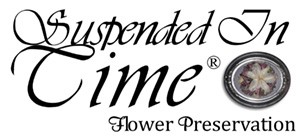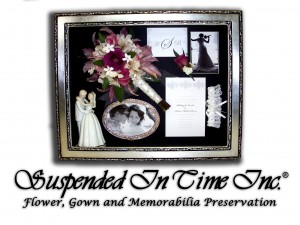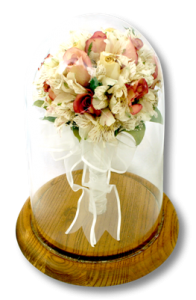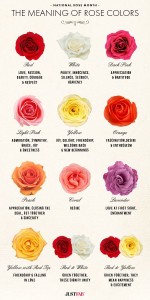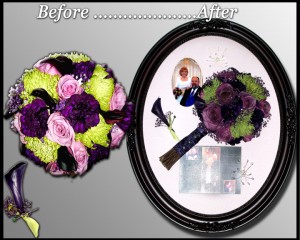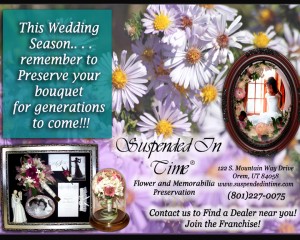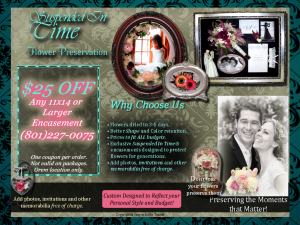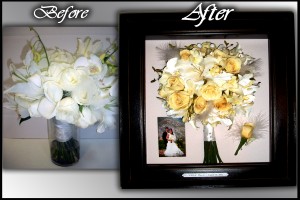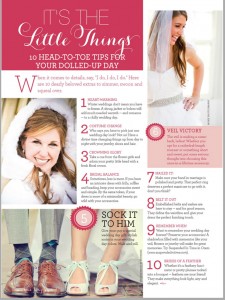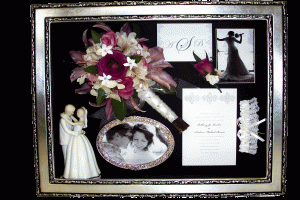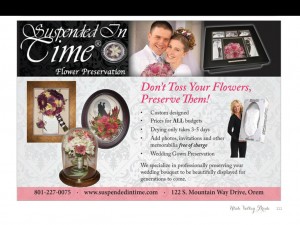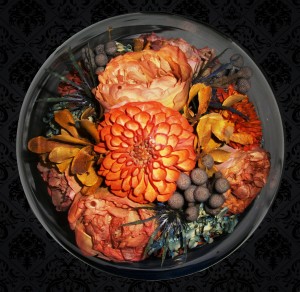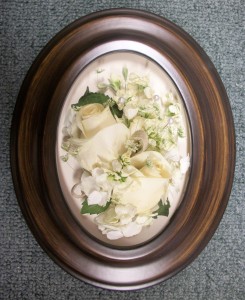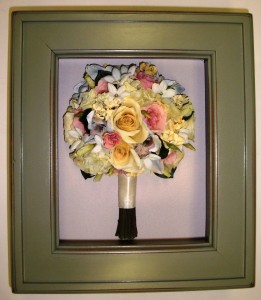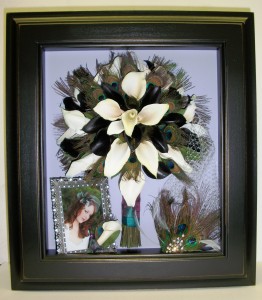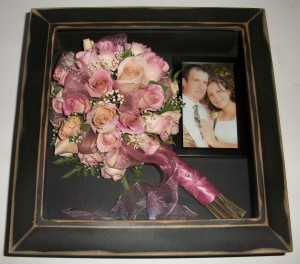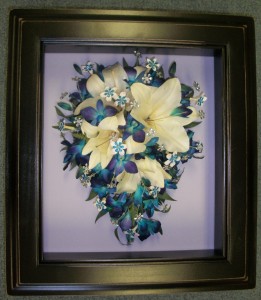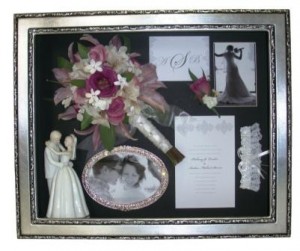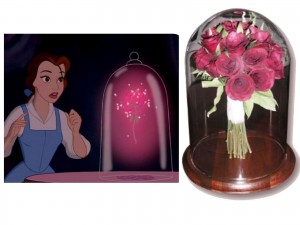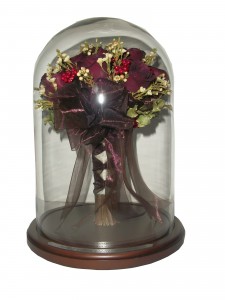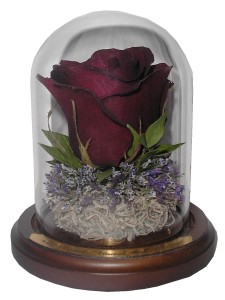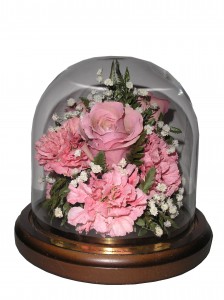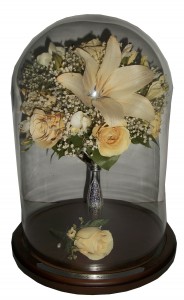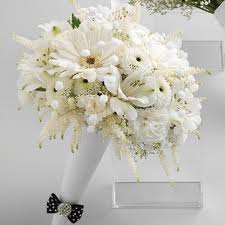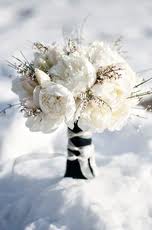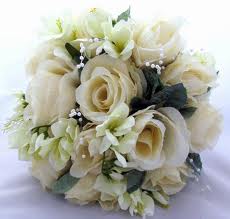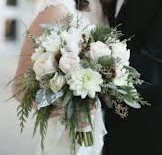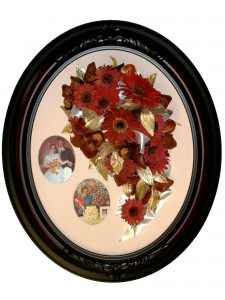 Remake your mother’s bouquet for her golden anniversary and have it preserved with before and after pictures of them. To find out more information about how to get your flowers done call (801)227-0075 or to find out how you can become a dealer in your own town.
Remake your mother’s bouquet for her golden anniversary and have it preserved with before and after pictures of them. To find out more information about how to get your flowers done call (801)227-0075 or to find out how you can become a dealer in your own town.
Tag Archives: bridal bouquet
Ashley Wallock Bridal Bouquet Preservation
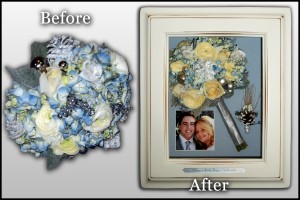 A friend of the bride picked up her encasement she had this to say, “The flowers turned out so beautiful. The colors are still so vibrant. We will cherish it forever.” Thank you, Liz Galbraith for your comments and we wish Ashley the best in her new adventure. If you want to preserve you flowers or learn how to do this for people around you contact us at (801) 227-0075.
A friend of the bride picked up her encasement she had this to say, “The flowers turned out so beautiful. The colors are still so vibrant. We will cherish it forever.” Thank you, Liz Galbraith for your comments and we wish Ashley the best in her new adventure. If you want to preserve you flowers or learn how to do this for people around you contact us at (801) 227-0075.
Suspended In Time Flower Preservation
Fun Wedding Facts
The Meaning of Rose Colors
Wedding Flowers: Top 10 Wedding Flowers
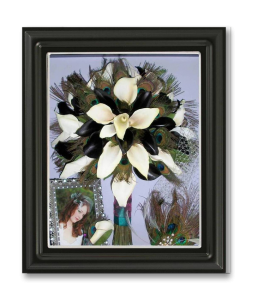 Having trouble picking your flowers from the
thousands of varieties available? Check out our
roundup of favorite wedding blossoms to help you
decide.
Having trouble picking your flowers from the
thousands of varieties available? Check out our
roundup of favorite wedding blossoms to help you
decide.
Picture yourself walking through a glorious garden with every flower at its peak. Which flowers would you pick for your wedding? The commonplace? The colorful? The rarest? Most fragrant? Unscented? Having trouble deciding from the thousands of varieties available? To help you narrow down your bouquet and centerpiece choices before you meet with your florist, we offer this overview of the top 10 most popular wedding flowers.
1. The Rose
Long considered a symbol of beauty and love, the rose figures into many myths and fairy tales. Romantic writers and poets have used the flower as a metaphor for emotion, beauty, passion, and true love throughout the ages. An all-star in the world of weddings, the rose is far from boring, particularly when it comes to color — the rose is available in solid colors and bicolor varieties, and there are striped roses and tipped roses as well. More than three thousand varieties of roses are grown commercially, many available year-round and that are surprisingly affordable. And though roses are associated with luxurious fragrance, not every rose is scented. Three main types are likely candidates for your wedding flowers: hybrid tea roses (the classic, uniformly-shaped commercial roses generally seen at your local florist), spray roses (a rose with five to 10 small heads on each stem and a “natural, garden-grown” look), and garden roses (expensive, old-fashioned varieties with bushy, open heads and delicious scents).
Learn more about roses — the quintessential wedding flower!
2. The Tulip
Although it’s most often associated with the Netherlands, this flower is actually a native of Persia. Representing “consuming love” and “happy years,” the tulip can be a meaningful wedding choice. The flowers are grown in a wide range of colors, including white and cream; pastels like pink, yellow, and peach; and vibrant hues like magenta, red, and purple. Available during much of the year, the most common tulips are very affordable, though rare varieties can be expensive. The versatile tulip can enhance both elegant wedding settings and more casual venues, and work well in almost any permutation — from bouquets to boutonnieres to table arrangements. Three main varieties are commonly used: Dutch tulips (typically seen at neighborhood florist shops and in gardens), French tulips (expensive and elegant, with extra-long stems and large tapered blooms), and parrot tulips (noted for their ruffled, striped petals in intense colors).
3. Calla Lily
Also known as the arum lily, this elegant, trumpet-shaped blossom originated in Africa and symbolizes “magnificent beauty” in the language of flowers. The calla lily’s distinctive form has been depicted in Art Nouveau and Art Deco works, in addition to twentieth-century photography. Two types are commonly available: a large-headed variety with a long, smooth stem and suitable for tall arrangements or presentation-style bouquets, and a miniature version ideal for nosegays and boutonnieres. Creamy ivory is the most popular color, but calla lilies also come in yellow, orange, mauve-pink, and dark purple.
4. Lily of the Valley
With bell-shape florets dangling from a thin stem, the lily of the valley is sometimes called “the ladder to heaven.” The fresh, perfumed scent from its tiny flowers is unmistakable. In Norse mythology, the flower is linked to Ostara, the goddess of springtime, and while most plentiful during this season, it remains available — and very expensive — most of the year. So while a fistful of lily of the valley might be your dream, a more affordable alternative may be to use just a few stems to infuse a bouquet or centerpiece with its wonderful fragrance. Most people know of the white variety, but lily of the valley also comes in a very rare rosy-pink.
5. Hydrangeas
With its big bushy head and intense shades of pink, blue, burgundy, and purple, it’s no wonder that the hydrangea represented “vanity” in the Victorian language of flowers. One of the most popular varieties changes in color as it grows from bubble-gum pink to sky blue, depending on the acid level of the soil. A stem or two of this moderately priced, scentless shrub flower helps fill out arrangements and bouquets, and a few sprigs make a charming boutonniere. You’ll find the hydrangea in white and shades of green, pink, burgundy, and blue.
6. The Peony
The peony has a large, full head, strong perfume, and bright color. But despite this outward showiness, the flower acquired the Victorian meaning “bashfulness.” Cultivated in Asia for more than a thousand years and developed further by the French, the peony is available in two main types, the herbaceous and the tree peony (the latter’s flowers do not last as long when cut). A bouquet made solely of peonies can be gorgeous; the flower can also be used to create beautiful centerpieces and arrangements. Grown in single- and double-flower styles, this expensive bloom is seasonally available from late spring to early summer but can be imported in the fall.
7. Ranunculus
Looking for a cost-effective alternative to roses or peonies? Try the lush, multi-petaled ranunculus, a relative of the buttercup. First seen by Westerners in the Far East around the thirteenth century, this mild-scented flower features several blossoms on a stem with fernlike foliage. To carry ranunculus is to tell your partner, in the Victorian language of flowers, “I am dazzled by your charms.” A natural for the bridal bouquet or bridesmaid nosegays, the ranunculus also makes a whimsical boutonniere and is available in many colors including white, yellow, orange, and pink.
8. Stephanotis
The Victorian meaning for this flower is “marital happiness,” making the dainty white Stephanotis an obvious choice for weddings. The star-shape, waxy florets actually grow on a flowering vine; each must be individually wired or placed onto a special holder before it can be arranged. A bouquet of stephanotis blossoms is one of the most traditional a bride can carry, and a stephanotis boutonniere is a classic choice for a formal wedding. Mildly scented, moderately priced, and available year-round.
9. Sweet Peas
The sweet pea, which signifies “lasting pleasure,” was first brought to England from Sicily in 1699, and the English have had a love affair with this delicate flower ever since. Its candy-like scent and ruffled blossoms make this an old-fashioned favorite in bouquets for the bride and her bridesmaids. The sweet pea’s many colors range from white to intense pinks and purples, and its scent can be strong and sweet.
10. The Gardenia
Surrounded by dark green, waxy leaves, the exquisite gardenia exudes a sultry, heavy scent. It was this intoxicating fragrance that captivated an English sea captain traveling through South Africa in 1754, prompting him to bring home one of the native plants as a souvenir. Gardenias are lovely tucked into a bouquet or floating in a low bowl as a centerpiece, and a single gardenia makes a wonderful scented corsage. But be gentle: the delicate, creamy ivory petals of this expensive flower can bruise easily. Large three- to four-inch blossoms, as well as a miniature variety, are available.
Adapted from The Knot Book of Wedding Flowers (Chronicle Books, 2002).
— The Knot
Read more: Wedding Flowers: Top 10 Wedding FlowersTheKnot.com – https://wedding.theknot.com/wedding-planning/wedding-flowers/articles/top-10-wedding-flowers.aspx#ixzz2Yi8LZPPj
https://wedding.theknot.com/wedding-planning/wedding-flowers/articles/top-10-wedding-flowers.aspx
6 bridal bouquet ideas
6 bridal bouquet ideas
© Watson Studios Photography / The KnotWatch Full Movie Online Streaming Online and Download
-
Resources from TheKnot.com
It’s true: We’ve come a long way from the days when brides carried bouquets down the aisle to ward off evil spirits (yes, that’s how the tradition started).
Though some trends have blossomed and others have wilted, one thing remains true: Flowers are a great way to make a highly personal statement, whether it’s a bloom’s more abstract Victorian meaning or just that it comes in your favorite color. Here are six easy ways to draw inspiration for your bouquets.
Tip 1: Channel History
Ever wonder why many brides carry stephanotis in their wedding bouquets (besides the fact that the flowers are so unique and gorgeous)? These creamy, star-shape florets carry a symbolic meaning of happiness in marriage.
Says who, you ask? Many such floral traditions are rooted in the conservative Victorian era, when every flower was given a symbolic meaning so that men could express their sentiments without words. Armed with a new edict, men began courting ladies not with love letters or serenades but with bouquets — and soon a lady receiving coral-color roses knew her suitor was expressing the first signs of desire, while a young maiden receiving a dainty cluster of violets might blush at the notion that her secret admirer had expressed his faithfulness to her. Learn the meanings of these popular wedding flowers and incorporate a little bit of history into your wedding day.
Here are a few of our favorites to get you started:
– lily of the valley = happiness
– calla lily = beauty
– freesia = innocence
– gardenia = joy
– orchid = love
– lilac = first signs of love
– anemone = expectation
More from The Knot: 15 flower mistakes to avoid
Tip 2: Color-Code It
Choosing colorful flowers that match your wedding palette is an obvious way to personalize your bouquet. But just because you’ve picked a pretty green-and-purple combo for your wedding, doesn’t mean your flowers need to scream eggplant!
Colorful adornments — from ribbons and fabric to beads and baubles — will make any bouquet meaningful. We love going with monochromatic blooms and bringing in color through the shape — and shade — of unusual additions, such as dark, rich berries, brilliant green succulents, or even jewel-tone sugared grapes.
Other examples: Do as the Romans did in times of celebration and add stalks of herbs to your bouquet, such as sweet-scented, pale purple lavender. Or take a bundle of typical white wedding blooms, like stephanotis or calla lilies, and tie the bouquet with a green wrap secured with a purple snap or button. You might even string purple- and green-accented paper cranes (for good luck) from your bouquet.
Tip 3: Check Backgrounds
Flowers can speak louder than vows — in all the pictures, at least. Another way to personalize is to choose flowers that match your personalities or are expressive of your backgrounds and beliefs.
For instance, you may choose to give a nod to his Norwegian heritage by including purple heather — Norway’s signature flower — in your bouquet and on the guys’ boutonnieres. Or you might pair your birth-month blooms like lily of the valley with chrysanthemum, because he was born in May and you in November. Or maybe your bedroom is always awash in tulips — your favorite bloom (a good choice, as they represent “consuming love”). Include these (you’ll find them mainly in three popular varieties — French, Dutch, and Parrot — though there are 3,000 varieties) in your bouquet. Did he propose while you were road-tripping in Georgia? Consider carrying a nosegay of peach-hued roses.
Tip 4: Keep It In The Family
Delve into your own family history and elevate the personal factor of your bouquet. Give your wedding flowers a homegrown flair by picking peonies from your mother’s garden; or you may choose to carry a cluster of white French tulips because your mother did so, as did her mother and her mother’s mother.
There are also less obvious ways to incorporate familial elements into your bouquet: Wrap the stems of your flowers in your favorite fabric topped off with your grandmother’s vintage hat pin, or create a bouquet wrap from an heirloom silk scarf. (Remember though, fabrics may be damaged by water and pins). Consider threading a relative’s pearls around soft rose petals to add sophistication to your wedding; or simply your the florist to take silk ribbons monogrammed with both of your initials and loop them through the bouquet.
More from The Knot: Unexpected flower ideas
Tip 5: Remember To Remember
Keeping in sync with your fiance and your bridesmaids will help you pick personalized flowers. Start by recalling a favorite date that you and your fiance had. Was it the time you enjoyed an afternoon picnic in the park and he brought along a bouquet of your favorite flower — daffodils — to commemorate the occasion? Consider carrying these blooms down the aisle. Or maybe he brought you daisies for your first date? Make sure your bouquet is bursting with them. Is his favorite eau de toilet that you wear lavender scented? Ask your florist to incorporate sprigs of sweet-scented lavender into your bouquet and onto his boutonniere. You might even ask your attendants what their favorite flowers are — you could include each of their favorites into your own arrangement.
Tip 6: Use Your Environment
Gather inspiration from the everyday elements around you. Some fresh takes: Dress a bouquet with faux freshwater pearls because you’re marrying at the beach, or dot your arrangement with small fruits for a touch of spring (we love kumquats, lemons, even cherries). Is your fall fete taking place in a botanical garden of sorts? A motif like butterflies might be an appropriate thread for your details — let ceramic or fabric ones peek out from behind the flower petals as a nod to the season. We’ve planted the seed — you’ll need to take it from here.
— Allison Micarelli
© 2013 The Knot. All rights reserved.
Restore Your Old Bouquet!!!
Brides Response When She Saw her Bouquet Restored:
“WOW! Seven years after our wedding my bridal bouquet was crumbled, dusty and sad! Now it looks as good as the day of our wedding. My flowers were the highlight of my wedding day and now I see them and smile everyday Thanks!”
~Jessica Benson
Kimikae Jones Bridal Bouquet Testimonial
Recently Kimikae Jones got her wedding bouquet preserved after her special day. When she came to pick it up at Suspended In Time Inc. (R) she was ecstatic and this is what she had to say when she saw it for the first time: “I’m so excited to have found Suspended In Time! When I saw my display, I got goose bumps and tears came to my eyes! They did an amazing job with the display and the flowers looked incredible! Thank you Suspended In Time for preserving my wedding memories so perfectly!!!” Kimikae, also had her wedding dress preserved through us and she was just as excited over how beautifully it was displayed. —We are happy that Kimikae was overjoyed and hope that we can bring that same happiness to many other brides soon.
History Behind the Wedding Ring
Till twentieth century, wedding rings were associated with women only. It was in the twentieth century that men started wearing wedding rings as well. The trend started during the World War II, when most of the men were separated from their wives for a lengthy duration. It was then they started wearing wedding bands, which served as a symbol of their marriage. They took it as a reminder of their wives, who were waiting for them to return. It was a gesture of love at that time, which has sustained as a practice till date.
https://lifestyle.iloveindia.com/lounge/history-of-wedding-ring-3552.html
Spring is here along with Wedding Season…Remember to Preserve you Bouquet
Wedding Bouquet Preservation Before and After
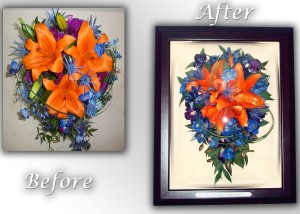 Eleanor Laflammel brought in her recently married daughters bouquet in order to get it preserved. Her daughter came in with her to pick it up and when she saw it she said, “The box is beautiful! The flowers were preserved wonderfully and look as great as they did on my wedding day.” Just like the Jeanette you too can get your special flowers preserved at Suspended In Time Inc. so that not only you but your children and grandchildren may enjoy them also.
Eleanor Laflammel brought in her recently married daughters bouquet in order to get it preserved. Her daughter came in with her to pick it up and when she saw it she said, “The box is beautiful! The flowers were preserved wonderfully and look as great as they did on my wedding day.” Just like the Jeanette you too can get your special flowers preserved at Suspended In Time Inc. so that not only you but your children and grandchildren may enjoy them also.
Karli White Bridal Bouquet-Before and After Flower Preservation
Suspended In Time Tips for Brides
See what we can create so you can remember your special day for years to come! Check out number 9 on the list and see what we can do for you! Utah Valley Bride included us in the 2013 Bridal Magazine in the section titled “It’s The Little Things”–“10 Head-To-Toe Tips For Your Dolled-Up Day!
Wedding Bouquet Table Dome Ideas
Katie Brinton’s Flowers
Katie says, “Thank you so much for your beautiful work! This will be an heirloom passed on from generation to generation. I love it & will recommend Suspended In Time to everyone I know getting married. It’s the perfect memory of such a perfect day!”
Thanks for the compliments Katie. We loved working with your flowers and are grateful that we could help you keep a memory of your special day!
Shadow Box Encasements
Suspended in Time Flower Preservation specializes in preserving and encasing your wedding bouquets, funeral spreads, and more! Shadow box encasements are a popular way to remember your special day/special person! Take a moment to look over some of the encasements we have done for previous customers.
Beauty and the Beast Style Wedding Bouquet Dome
Winter Wedding Bouquets
Winter bouquets are often simple, elegant, and light. Here are a few beautiful examples you could consider when planning your own wedding bouquet!
Once you’ve chosen your bouquet, don’t forget that you can keep it forever by bringing it to professional flower preservation specialists, such as Suspended in Time Flower Preservation, Inc. Visit our site at www.suspendedintime.com to see how we can make your memory last a life time!
